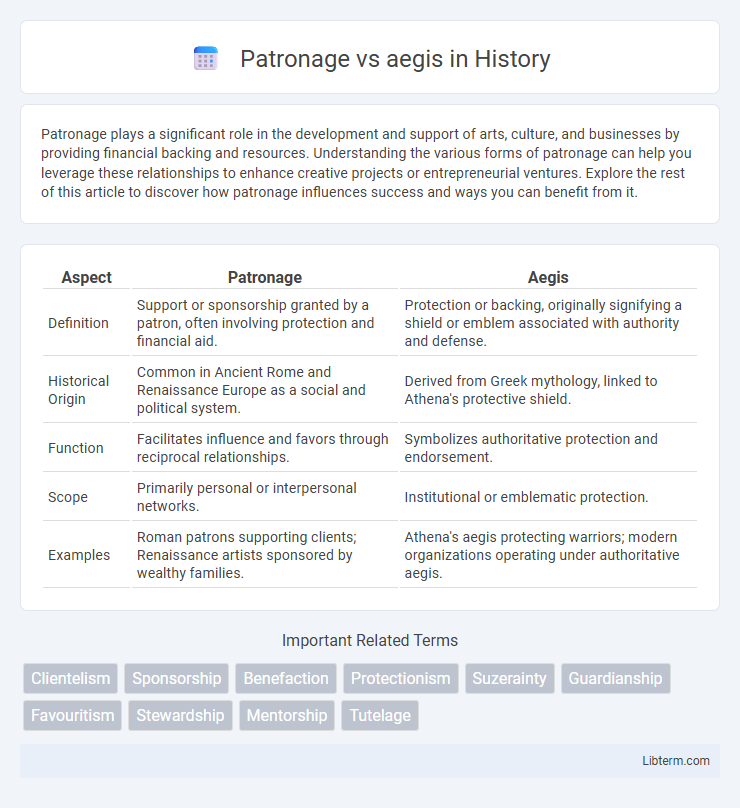Patronage plays a significant role in the development and support of arts, culture, and businesses by providing financial backing and resources. Understanding the various forms of patronage can help you leverage these relationships to enhance creative projects or entrepreneurial ventures. Explore the rest of this article to discover how patronage influences success and ways you can benefit from it.
Table of Comparison
| Aspect | Patronage | Aegis |
|---|---|---|
| Definition | Support or sponsorship granted by a patron, often involving protection and financial aid. | Protection or backing, originally signifying a shield or emblem associated with authority and defense. |
| Historical Origin | Common in Ancient Rome and Renaissance Europe as a social and political system. | Derived from Greek mythology, linked to Athena's protective shield. |
| Function | Facilitates influence and favors through reciprocal relationships. | Symbolizes authoritative protection and endorsement. |
| Scope | Primarily personal or interpersonal networks. | Institutional or emblematic protection. |
| Examples | Roman patrons supporting clients; Renaissance artists sponsored by wealthy families. | Athena's aegis protecting warriors; modern organizations operating under authoritative aegis. |
Understanding Patronage: Definition and Context
Patronage refers to the support or sponsorship provided by a patron to an individual, organization, or cause, often involving financial aid, protection, or social influence. It is rooted in historical and cultural contexts where patrons endorse artists, scholars, or political figures to advance their work or status. Understanding patronage involves recognizing the reciprocal relationship between the patron's power and the beneficiary's dependence on this support.
Aegis Explained: Origins and Meaning
The term "aegis" originates from Greek mythology, referring to the protective shield or breastplate associated with Zeus and Athena, symbolizing divine protection and authority. In modern usage, aegis denotes sponsorship or protection under a powerful organization or individual, emphasizing safeguarding and support. Unlike patronage, which often implies financial support or endorsement, aegis highlights protective guardianship and authoritative backing.
Historical Perspectives: Patronage vs. Aegis
Historical perspectives reveal that patronage involved influential individuals or entities providing support and protection to artists, intellectuals, or institutions, often shaping cultural and political landscapes. Aegis, rooted in ancient Greek mythology, symbolized divine protection or sponsorship, typically representing authoritative guardianship rather than personalized support. Understanding patronage emphasizes reciprocal relationships and social capital, while aegis highlights overarching protective authority within historical contexts.
Key Differences Between Patronage and Aegis
Patronage refers to the support or financial sponsorship provided by a patron to an individual or organization, often involving ongoing backing or protection in arts, business, or politics. Aegis, derived from ancient mythology, signifies shield or protection, symbolizing authoritative endorsement or sponsorship rather than direct active involvement. Key differences include patronage's emphasis on sustained support and influence, compared to aegis's role as a symbolic shield or umbrella under which activities occur, with aegis often implying formal or official authorization.
The Role of Power Dynamics in Patronage and Aegis
Power dynamics in patronage revolve around a reciprocal relationship where patrons provide resources or protection in exchange for loyalty and service, often creating dependencies that reinforce hierarchical social structures. In contrast, aegis implies protective support typically granted by a powerful entity, such as a state or institution, serving more as a protective shield that legitimizes and safeguards the beneficiary without demanding explicit obligations. The nuances in power distribution differentiate patronage's transactional nature from aegis's protective endorsement, highlighting how authority is exercised and negotiated in various socio-political contexts.
Patronage in Art, Politics, and Society
Patronage in art, politics, and society serves as a powerful mechanism whereby influential individuals or institutions provide support, funding, and protection to artists, politicians, and social movements, fostering cultural development and political influence. This system not only enables the creation of significant artworks and political ideologies but also shapes social hierarchies by reinforcing the authority and prestige of patrons. Unlike aegis, which implies a protective or sponsoring shield, patronage involves active engagement and resource allocation that drives innovation and power dynamics within societal structures.
Aegis in Mythology, Law, and Modern Usage
The aegis in mythology is a protective shield or breastplate associated with Zeus and Athena, symbolizing divine protection and authority. In legal contexts, aegis refers to the sponsorship or backing of an organization or individual, often implying responsibility or endorsement. Modern usage of aegis extends to denote protection, support, or guidance under a particular entity or authority, emphasizing shielding and patronage benefits.
Advantages and Disadvantages of Patronage Systems
Patronage systems offer advantages such as personalized support, fostering loyalty, and creating mutually beneficial relationships between patrons and clients. However, disadvantages include potential corruption, favoritism, and inefficiency as resources may be allocated based on connections rather than merit. These systems can undermine institutional integrity and hinder equal opportunities within social or political structures.
Aegis as Protection: Benefits and Limitations
Aegis, derived from ancient Greek mythology, symbolizes protection and support, often associated with a shield offering divine defense. Its benefits include providing a strong sense of security and legitimacy, fostering trust and stability in relationships or organizations under its influence. However, the limitations of aegis lie in potential dependency and reduced autonomy, as those under its protection may rely too heavily on external support rather than developing independent strength.
Choosing Between Patronage and Aegis: Practical Implications
Choosing between patronage and aegis involves evaluating the scope of support and autonomy offered; patronage provides financial or resource backing often with expectations of loyalty, while aegis offers protective oversight with potential influence over strategic decisions. Organizations seeking flexible collaboration may prefer patronage to leverage specific resources without full control relinquishment. In contrast, aegis suits entities requiring structured protection and alignment with authoritative guidance for stability and risk mitigation.
Patronage Infographic

 libterm.com
libterm.com